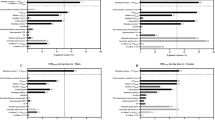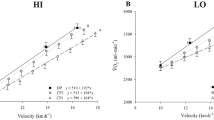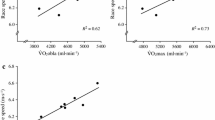Abstract
Our aim was to investigate the relationship between physiological variables (not previously studied) and performance in elite 1,500-m runners. We assessed eight male athletes with an average personal best time of 233.3 ± 6.9 s (110% of the world record) for the 1,500-m race. Ventilatory measurements, maximal oxygen consumption \( (\dot{V}{\text{O}}_{{2{\max }}} ), \) maximal vastus lateralis muscle deoxygenation (∆[deoxy(Hb+Mb)])max via near-infrared spectroscopy (NIRS), and maximal velocity (V max) were obtained during an incremental treadmill test. During subsequent constant-speed exercise at V max, we determined the time to exhaustion (Tlim), end-exercise blood lactate concentration ([La]bmax), \( \dot{V} {\text{O}}_{2} \) and ∆[deoxy(Hb+Mb)] kinetics parameters. The mean \( \dot{V} {\text{O}}_{{2{ \max }}} , \) [La]bmax and V max were 70.2 ± 3.9 mL kg−1 min−1, 12.7 ± 2.4 mmol L−1, 21.5 ± 0.5 km h−1, respectively. \( \dot{V} {\text{O}}_{2} \) at V max showed a significant negative correlation with Tlim, whereas [La]bmax was positively correlated with Tlim. Race speed was found to significantly correlate with ∆[deoxy(Hb+Mb)]max (79% of maximal value obtained during a transient limb ischemia), ∆[deoxy(Hb+Mb)] slow component (22.9 ± 9.3% of total amplitude) and [La]bmax at V max. [La]bmax at V max was also significantly correlated with ∆[deoxy(Hb+Mb)] slow component, suggesting a greater release of oxygen from the hemoglobin due to the Bohr effect. We conclude that both the maximal capacity of muscle to extract O2 from the blood and the end-exercise blood lactate accumulation are important predictors of best performance in 1,500-m runners.





Similar content being viewed by others
References
Astrand I (1960) Aerobic work capacity in men and women with special reference to age. Acta Physiol Scand 169:1–92
Beaver WL, Wasserman K, Whipp BJ (1986) A new method for detecting anaerobic threshold by gas exchange. J Appl Physiol 60:2020–2027
Billat VL, Beillot J, Jan J, Rochcongar P, Carre F (1996) Gender effect on the relationship of time limit at 100% VO2max with other bioenergetic characteristics. Med Sci Sports Exerc 28(8):1049–1055
Billat VL, Slawinski J, Danel M, Koralsztein JP (2001) Effect of free versus constant pace on performance and oxygen kinetics in running. Med Sci Sports Exerc 33(12):2082–2088
Billat VL, Lepretre PM, Heugas AM, Koralsztein JP (2004) Energetics of middle-distance running performances in male and female junior using track measurements. Jpn J Physiol 54(2):125–135
Billat V, Hamard L, Koralsztein JP, Morton RH (2009) Differential modelling of anaerobic and aerobic metabolism in the 800-m and 1,500-m run. J Appl Physiol 107:478–487
Brooks GA (1991) Current concepts in lactate exchange. Med Sci Sports Exerc 23:895–906
Brooks GA (2007) Lactate. Link between glycolytic and oxidative metabolism. Sports Med 37(4–5):341–343
Calbet JAL, Holmberg H-C, Rosdahl H, van Hall G, Jensen-Urstad M, Saltin B (2005) Why do arms extract less oxygen than legs during exercise? Am J Physiol Regul Integr Comp Physiol 289:R1448–R1458
Daniels J, Daniels N (1992) Running economy of elite male and elite female runners. Med Sci Sports Exerc 24:483–489
Di Prampero PE (1981) Energetics of muscular exercise. Rev Physiol Biochem Pharmacol 89:143–222
Endo MY, Kobayakawa M, Kinugasa R et al (2007) Thigh muscle activation distribution and pulmonary VO2 kinetics during moderate, heavy, and very heavy intensity cycling exercise in humans. Am J Physiol Regul Integr Comp Physiol 293:R812–R820
Ferreira LF, Townsend DK, Lutjemeier BJ, Barstow TJ (2005) Muscle capillary blood flow kinetics estimated from pulmonary O2 uptake and near-infrared spectroscopy. J Appl Physiol 98:1820–1828
Foster C, Costill DL, Daniels JT, Fink WJ (1978) Skeletal muscle enzyme activity, fiber composition and VO2max in relation to distance running performance. Eur J Appl Physiol Occup Physiol 39(2):73–80
Grassi B, Poole DC, Richardson RS, Knight DR, Erickson BK, Wagner PD (1996) Muscle O2 uptake kinetics in humans: implications for metabolic control. J Appl Physiol 80:988–998
Grassi B, Pogliaghi S, Rampichini S et al (2003) Muscle oxygenation and pulmonary gas exchange kinetics during cycling exercise on-transitions in human. J Appl Physiol 95:149–158
Hanon C, Leveque JM, Thomas C, Vivier L (2008) Pacing strategy and VO2 kinetics during a 1,500-m race. Int J Sports Med 29:206–211
Hughson RL, O’Leary DD, Betik AC, Hebestreit H (2000) Kinetics of oxygen uptake at the onset of exercise near or above peak oxygen uptake. J Appl Physiol 88:1812–1819
Ingham SA, Whyte GP, Pedlar C, Bailey DM, Dunman N, Nevill AM (2008) Determinants of 800-m and 1,500-m running performance using allometric models. Med Sci Sports Exerc 40(2):345–350
Jones AM, Wilkerson DP, Vanhatalo A, Burnley M (2008) Influence of pacing strategy on O2 uptake and exercise tolerance. Scand J Med Sci Sports 18:615–626
Jones AM, Grassi B, Christensen PM, Krustrup P, Bangsbo J, Poole DC (2011) Slow component of VO2 kinetics: mechanistic bases and practical applications. Med Sci Sports Exerc 43(11):2046–2062
Kalliokoski KK, Oikonen V, Takala TO, Sipila H, Knuuti J, Nuutila P (2001) Enhanced oxygen extraction and reduced flow heterogeneity in exercising muscle in endurance-trained men. Am J Physiol Endocrinol Metab 280:E1015–E1021
Kowalchuck JM, Rossiter HB, Ward SA, Whipp BJ (2002) The effect of resistive breathing on leg muscle oxygenation using near-infrared spectroscopy during exercise in men. Exp Physiol 87:601–611
Lacour JR, Padilla-Magunacelaya S, Barthélémy JC, Dormois D (1990) The energetics of middle-distance running. Eur J Appl Physiol Occup Physiol 60(1):38–43
Legrand R, Ahmaidi S, Moalla W, Chocquet D, Marles A, Prieur F, Mucci P (2005) O2 arterial desaturation in endurance athletes increases muscle deoxygenation. Med Sci Sports Exerc 37(5):782–788
Mancini DM, Bolinger L, Li H, Kendrick K, Chance B, Wilson JR (1994) Validation of near infrared spectroscopy in humans. J Appl Physiol 77:2740–2747
Noakes TD (1988) Implication of exercise testing for the prediction of athletic performance: a contemporary perspective. Med Sci Sports Exerc 4:319–330
Poole DC, Wilkerson DP, Jones AM (2008) Validity of criteria for establishing maximal O2 uptake during ramp exercise tests. Eur J Appl Physiol 102:403–410
Roca J, Agusti AGN, Alonso A et al (1992) Effects of training on muscle O2 transport at VO2max. J Appl Physiol 73:1067–1076
Rossiter HB, Ward SA, Kowalchuk JM, Howe FA, Griffiths JR, Whipp BJ (2002) Dynamic asymmetry of phosphocreatine concentration and O2 uptake between the on- and off-transients of moderate- and high-intensity exercise in humans. J Physiol 541:991–1002
Saunders PU, Pyne DB, Telford RD, Hawley JA (2004) Factors affecting running economy in rained distance runners. Sports Med 34:465–485
Shiga T, Yamamoto K, Tanabe K, Nakase Y, Chance B (1997) Study of an algorithm based on model experiments and diffusion theory for a portable tissue oximeter. J Biomed Opt 2:154–161
Spencer MR, Gastin PB (2001) Energy system contribution during 200- to 1,500-m running in highly trained athletes. Med Sci Sports Exerc 33(1):157–162
Tran TK, Sailasuta N, Kreutzer U et al (1999) Comparative analysis of NMR and NIRS measurements of intracellular PO2 in human skeletal muscle. Am J Physiol Regul Integr Comp Physiol 276:R1682–R1690
Wagner PD (2000) Diffusive resistance to O2 transport in muscle. Acta Physiol Scand 168:609–614
Walley KR (1996) Heterogeneity of oxygen delivery impairs oxygen extraction by peripheral tissues: theory. J Appl Physiol 81:885–894
Weston AR, Mbambo Z, Myburgh KH (2000) Running economy of African and Caucasian distance runners. Med Sci Sports Exerc 32:1130–1134
Whipp BJ (1994) The slow component of O2 uptake kinetics during heavy exercise. Med Sci Sports Exerc 26:1319–1326
Whipp BJ, Rossiter HB, Ward SA (2002) Exertional oxygen uptake kinetics: a stamen of stamina? Biochem Soc Trans 30:237–247
Zoladz JA, Gladden LB, Hogan MC, Nieckarz Z, Grassi B (2008) Progressive recruitment of muscle fibers is not necessary for the slow component of VO2 kinetics. J Appl Physiol 105:575–580
Acknowledgments
We wish to thank all the athletes who volunteered for this study, their coaches Silvano Danzi and Pierino Endrizzi, and Dr Claudio Marconi who hosted us in his laboratory. We also thank Dr Francesca Lanfranconi for technical assistance. This research was funded by the University of Milano-Bicocca.
Conflict of interest
The authors declare no conflict of interest of financial or otherwise nature.
Author information
Authors and Affiliations
Corresponding author
Additional information
Communicated by Guido Ferretti.
Rights and permissions
About this article
Cite this article
Ferri, A., Adamo, S., La Torre, A. et al. Determinants of performance in 1,500-m runners. Eur J Appl Physiol 112, 3033–3043 (2012). https://doi.org/10.1007/s00421-011-2251-2
Received:
Accepted:
Published:
Issue Date:
DOI: https://doi.org/10.1007/s00421-011-2251-2




